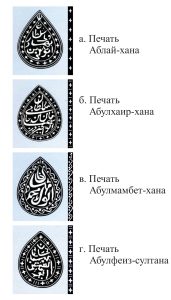




One of the most important symbols of the ruling elite were the rings. According to some sources, they “had “almost a standard tropical shape, which shows that the monopoly possession of such an exclusive signet ring is the aristocratic possession of the Chingizids” [15, p.22]. It is noteworthy that the teardrop shape is one of the canonical shapes of the Kazakh zerger (the ring qūs mūryn). This shape was reserved exclusively for the sultan’s signet ring (khan’s seal), the elders had a square, oval or round shape. The shape of the sultan’s signet ring (facing upwards) indicated the heavenly sphere, because its wearer was, according to ancient conception, the representative of the eternal blue sky on earth. The signet ring is one of the most important symbols of power, an indicator of the high status of its wearer, his special rights due to his birth.
The shape of all the signet rings was ornate, but judging from the patterns of the sultan’s signet rings, these had the most elegant design. The entire shape of the ring was framed by two thin lines, filled inside with either zigzag shapes or a combination of other rhythmically arranged elements. The main field of the ring was filled with an elegant Arabic inscription indicating the identity of the wearer.The signet rings were made of sacred silver metal, semantically associated with the moon (celestial metal). Experts speak of the existence of wooden boxes for their storage, made in the form of rolled ram horns. The horn(s) from Indo-European times is/are a symbol of Khvarenah – royal glory and divine grace.
The material of manufacture, the shape of the ring and its decoration, together with the concrete inscription and all other attributes emphasized the splendor and greatness of the Khan’s power.


